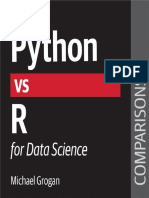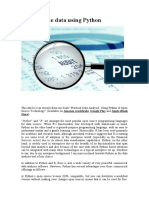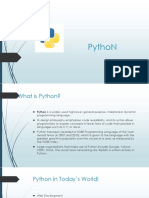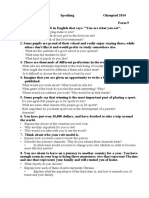Python vs R for Data Science
Uploaded by
Prashant ChourasiyaPython vs R for Data Science
Uploaded by
Prashant ChourasiyaPython vs R for data science
Python and R are both widely used programming languages in data science, each with unique
strengths and applications. Here's a detailed comparison to help you decide which language
suits your needs:
Key Differences Between Python and R
Feature Python R
Primary General-purpose language, strong in Designed for statistical computing and
Objective machine learning (ML) and app development data visualization tasks
Easy to learn with clear syntax, ideal for Steeper learning curve, especially for
Ease of Learning
beginners those without a statistical background
Data Libraries like Matplotlib, Seaborn, and Plotly Excels in visualization with libraries like
Visualization offer good visualization capabilities ggplot2, Lattice, and Esquisse
Machine Extensive ML libraries like TensorFlow, Limited ML support but includes
Learning PyTorch, and scikit-learn packages like Caret and mlr3
Better integration with web apps, databases, Primarily focused on local statistical
Integration
and production systems analysis
Faster for large datasets and computational
Speed Slower due to its interpreted nature
tasks
Community & Larger community with over 300,000 Smaller but specialized community with
Libraries libraries ~20,000 packages
When to Use Python
Machine Learning & AI: Python is better suited for building machine learning models and
deploying them into production environments.
General-Purpose Applications: Its versatility makes it ideal for tasks beyond data science,
such as web development or automation.
Ease of Use: Beginners often find Python easier to learn due to its intuitive syntax.
When to Use R
Statistical Analysis: R is the go-to language for statisticians due to its specialized
packages for hypothesis testing, regression modeling, etc.
Data Visualization: If creating advanced visualizations is a priority, R's ggplot2 and related
tools are unmatched.
Academic Research: R is widely used in academia for statistical research.
Conclusion
Choose Python if you need a versatile language that supports machine learning, application
development, and seamless integration into production systems.
Opt for R if your work focuses on statistical analysis, academic research, or creating high-
quality visualizations.
For many projects, combining both languages can leverage their respective strengths. Tools like
reticulate (in R) or rpy2 (in Python) allow integration between the two.
You might also like
- Data Analysis From Scratch With Python - Beginner Guide Using Python, Pandas, NumPy, Scikit-Learn, IPython, TensorFlow and100% (10)Data Analysis From Scratch With Python - Beginner Guide Using Python, Pandas, NumPy, Scikit-Learn, IPython, TensorFlow and104 pages
- Chapter 1 Thinking Critically With Psychological Science, Myers 8e Psychology100% (8)Chapter 1 Thinking Critically With Psychological Science, Myers 8e Psychology26 pages
- Reading 3 - Programming For Data ScienceNo ratings yetReading 3 - Programming For Data Science6 pages
- Python_vs_R_for_Data_Science_1725025528No ratings yetPython_vs_R_for_Data_Science_172502552810 pages
- Comparative Analysis of R and Python For Mathematical ProgrammingNo ratings yetComparative Analysis of R and Python For Mathematical Programming4 pages
- APznzaYFSYN7HfKT47uBOgy87rIMPHIRyJa0gVq-f59OfljwVybitiAPWEv_XOUqCVjlejwQyK9WRnC8vVgsGVZfFDp9dlKU2MmEx044EMQ-1PyhLuR97p7ZZvL-1luTtSZZqG1c26969gmzBST8Pa7NbPMkg946VEM0UL76hrFjD0_lQs1FWA_F35v6hnJ8Bs0pkYT8V94rtOAO8OWcgcxHEmpJA47QxC4ukAu54kJWAEiuNo ratings yetAPznzaYFSYN7HfKT47uBOgy87rIMPHIRyJa0gVq-f59OfljwVybitiAPWEv_XOUqCVjlejwQyK9WRnC8vVgsGVZfFDp9dlKU2MmEx044EMQ-1PyhLuR97p7ZZvL-1luTtSZZqG1c26969gmzBST8Pa7NbPMkg946VEM0UL76hrFjD0_lQs1FWA_F35v6hnJ8Bs0pkYT8V94rtOAO8OWcgcxHEmpJA47QxC4ukAu54kJWAEiu22 pages
- Handout 1 - Introduction To Setting Up PythonNo ratings yetHandout 1 - Introduction To Setting Up Python49 pages
- Reference-guide_-Python-for-machine-learningNo ratings yetReference-guide_-Python-for-machine-learning4 pages
- Michael Grogan - Python Vs R For Data Science-O'Reilly Media (2018)50% (2)Michael Grogan - Python Vs R For Data Science-O'Reilly Media (2018)14 pages
- What Is Python?: Why Python For Data Science?No ratings yetWhat Is Python?: Why Python For Data Science?3 pages
- Python Programming: General-Purpose Libraries; NumPy,Pandas,Matplotlib,Seaborn,Requests,os & sys: Python, #2From EverandPython Programming: General-Purpose Libraries; NumPy,Pandas,Matplotlib,Seaborn,Requests,os & sys: Python, #2No ratings yet
- Data Analysis of Visualization: CHAPTER - 1 PreliminariesNo ratings yetData Analysis of Visualization: CHAPTER - 1 Preliminaries93 pages
- Python For Data Analytics Scientific and Technical ApplicationsNo ratings yetPython For Data Analytics Scientific and Technical Applications6 pages
- Why Python Rocks For Research: ProgrammingNo ratings yetWhy Python Rocks For Research: Programming5 pages
- Basics of Python Programming and StatisticsNo ratings yetBasics of Python Programming and Statistics56 pages
- Data Driven Guide for Python Programming : Master Essentials to Advanced Data StructuresFrom EverandData Driven Guide for Python Programming : Master Essentials to Advanced Data StructuresNo ratings yet
- Python for AI: Applying Machine Learning in Everyday ProjectsFrom EverandPython for AI: Applying Machine Learning in Everyday ProjectsNo ratings yet
- Python - A Emerging Superstar For Those Choosing Data ScienceNo ratings yetPython - A Emerging Superstar For Those Choosing Data Science3 pages
- A Comparative Study of Computational PackagesNo ratings yetA Comparative Study of Computational Packages4 pages
- IEEE Paper (DEVELOPMENT OF PROGRAMMING LANGUAGE PYTHON)No ratings yetIEEE Paper (DEVELOPMENT OF PROGRAMMING LANGUAGE PYTHON)16 pages
- please explain modals in more detail with many examplesNo ratings yetplease explain modals in more detail with many examples3 pages
- document.body.removeChild(paragraphs[paragraphs.leNo ratings yetdocument.body.removeChild(paragraphs[paragraphs.le2 pages
- Immediate Download Emotion Measurement 1st Edition Meiselman Ebooks 2024100% (2)Immediate Download Emotion Measurement 1st Edition Meiselman Ebooks 202454 pages
- Contextualized Online Document Management SystemNo ratings yetContextualized Online Document Management System10 pages
- Test Bank for Social Psychology, 3rd Edition : Gilovich - Complete Set Of Chapters Available For Instant Download100% (3)Test Bank for Social Psychology, 3rd Edition : Gilovich - Complete Set Of Chapters Available For Instant Download52 pages
- Where to Study Test Slot - 3 ( Test 19 -32)No ratings yetWhere to Study Test Slot - 3 ( Test 19 -32)7 pages
- The National Service Reserve Corps (NSRC) of The National Service Training Program (NSTP)100% (1)The National Service Reserve Corps (NSRC) of The National Service Training Program (NSTP)12 pages
- Managerial Leadership and Performance As Fully Mediated by Transformational Leadership Through Structural Equation ModelingNo ratings yetManagerial Leadership and Performance As Fully Mediated by Transformational Leadership Through Structural Equation Modeling8 pages
- Industry and Competitive Landscape Analysis - Course OutlineNo ratings yetIndustry and Competitive Landscape Analysis - Course Outline11 pages































































































